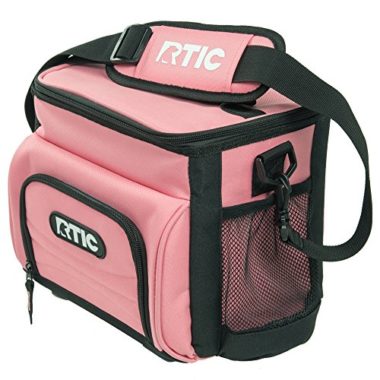How To Choose Between RTIC vs Yeti Coolers – Buying Guide

From ice life to construction quality, there are several things to consider when picking the best cooler from RTIC vs Yeti. Both companies make great products, but it’s these small details that can turn the scale one way or the other.
Coolers Ice Life
Long ice life is always one of the main concerns when buying a new cooler. In plain words, this info shows you how long the cooler can maintain ice before the last cube inside melts.
When you compare them based on this, these two brands are very similar – both have the robust build quality and thick insulation. Keep in mind that larger coolers have thicker walls and can fit more ice inside, so the cold retention will be longer regardless of the brand.
RTIC: In both soft and hard coolers, RTIC uses high-density closed-cell foam. While it’s a good material, the performance depends on its thickness and the wall quality. Soft coolers and day packs usually last for about 24 to 48 hours, while large hard-sided coolers claim to have an ice life of 7-10 days (in ideal conditions).
Yeti: While Yeti doesn’t give out official information about ice life, reviews and numerous tests have shown that the ice life is pretty much the same – 1-2 days for soft coolers, 3 days for the backpack, and a max of 7 days for the hard-sided Tundra ice chests. Yeti uses its patented ColdCell technology which is very similar to the one that RTIC uses.
So, which one is better at keeping ice? Well, it’s hard to say. Testing shows almost identical results, with the slight advantage going to RTIC. The reason for this is that RTIC coolers have a slightly larger interior volume within the same size range, meaning that you can pack more inside.
Coolers Ice Capacity (Volume)
When selecting the best coolers, the total volume often plays a crucial role in our decision. Both manufacturers usually show this parameter by calculating how many standard-sized beer cans you can fit inside, along with plenty of ice. Before we dig into the differences, you should know that Yeti offers a significantly larger number of sizes compared to RTIC coolers.
RTIC: Starting with the soft-sided models, RTIC Softpak sizes range from 8 to 40 cans (5.5 to 35 quarts). As for the hard-sided RTIC coolers, you can get them in sizes from 20 to 145 cans (22 to 145 quarts). While the size choice is a bit limited in comparison, RTIC products usually have a larger internal volume compared to Yetis with the same external dimensions.
Yeti: Yeti has an advantage in this segment, at least when talking about extra-large models. Their Hopper series is pretty much the same as Softpack RTIC coolers (8 to 40), but the Tundra series ranges from 20 to staggering 350 quarts.
Coolers Exterior and Interior
When they started out a little over 5 years ago, RTIC made it their goal to take all the good solutions from Yeti and implement them in their own design. As a direct result of this, you won’t be able to find much difference in quality and design between the two.
When talking about hard-sided coolers, both manufacturers make them from high-quality plastic, in fact, they are both roto molded coolers. This makes them virtually indestructible – great for sitting and climbing on and even resisting bear break-in attempts.
As for soft-sided coolers, there is a small difference in construction. While the RTIC Softpak coolers use almost the same material as Yeti’s Hopper series (waterproof laminated fabric), the RTIC Day Coolers are made from tougher polyester but with less water-resistance.
Since all of these are made for storing your food and beverage, the interior needs to be up to quality standards. Luckily, both manufacturers use FDA-approved materials that won’t impact your food in any way. Also, they won’t retain smell or develop mildew regardless of the model you pick.
Finally, we should mention the additional elements of these coolers. As you’ve probably noticed in the reviews, there’s not much difference between them (especially for the hard-sided models). The latches, gaskets, feet, and tie-downs are pretty much the same in both their design and their quality.
Durability
In 2006, YETI revolutionalized the industry by creating rotomolded coolers with shells that could be compared to those used for kayaks. These coolers could survive being driven over, dropped from moving vehicles, and even bear attacks. Even though they began nearly 8 years later, RTIC coolers caught up quickly and now offer a similar level of durability.
You might also be interested in:
Kayak Cooler
Perfect YETI Coolers
Still, if you want to have full peace of mind, you should probably go with a Yeti. The main reason we say this is because they put their products through more rigorous testing and they’ve been doing it for a longer time. This is not to claim that RTIC products won’t do the same job, but it’s probably the safer way to go.
This being said, both RTIC and Yeti coolers are made with top-quality materials. While RTIC may be lacking some certificates (like the Bear-safe badge), RTIC cooler reviews reveal plenty of satisfied customers who claim that their coolers can resist pretty much anything.
Ease Of Use
Thanks to all their design similarities, both brands offer coolers that are convenient and easy to use. Regardless if you get a soft or a hard cooler, you shouldn’t expect any problems with packing, performance, or portability. However, there are some small distinctions that are worth mentioning.
Hard-sided coolers: While the RTIC hard-sided ice chest series is pretty much the same as Yeti’s Tundra series, there are a few differences that people noticed. First, RTIC coolers have a foam grip on the side handles, compared to tough rubber provided by Yeti. While this is more comfortable to hold, users are sometimes worried about durability.
Also, some people complain that the T-latches on RTIC models are stiffer, making them a bit more difficult to use. Unfortunately, neither brand offers wheels on their coolers, which makes larger models a bit difficult to transport if they are fully packed.
Soft-sided coolers: We haven’t come across any problems with soft coolers from either manufacturer. Like we’ve mentioned earlier, RTIC SoftPak and Yeti Hopper have a very similar design – a compact case with several side handles and an adjustable shoulder strap for easier carrying. Keep in mind though, that all soft coolers have a significantly shorter ice life than hard-sided models.
Related Review: Soft Cooler
Extra Features
Extra features are the first spot where you can actually see some real differences between the two. Yeti invests a lot in research and development and, because of this, they offer many great accessories. These include dry baskets, dry duffel bags, Yeti ice, Hitchpoint grid, MOLLE bottle openers, and many others. On top of this, Yeti offers countless branding and customization options.
On the other hand, RTIC products don’t feature any of these, except for the occasional D-ring on the soft models. However, this allows RTIC to keep the price significantly lower. Whether all this is worth paying more is completely up to you and what you expect from your new ice chest.
Warranty
When you’re investing in an expensive cooler, it’s perfectly normal to expect it to last for many years. A good warranty can give you peace of mind so you don’t have to worry. When you compare RTIC and Yeti coolers, Yeti gives a much better warranty coverage, as well as customer support for their products.
RTIC: Even though we’ve said that RTIC has almost matched the quality of Yeti, they still have a long way to go in terms of customer support. A number of people have reported that their customer service is very slow in responding and helping you out. Their hard and soft-sided coolers come with a 1-year warranty, while the day coolers have a 90-day coverage.
Yeti: On the flip side, Yeti have become well known for their excellent and friendly customer service. Even though that is to be expected considering the cost, it’s nice to know that they will completely back up the product you buy. All their soft-sided coolers come with a 3-year warranty, while hard coolers are covered for 5 years.
FAQs

Q: What Are Yeti Coolers Best At?
A: When listing their advantages, Yeti coolers offer a much better size range (including very large models). This is great if you need a big chest to preserve your catch when going hunting or fishing. Another advantage is Yeti’s customer service – they will resolve your problem quickly and give you a much longer warranty.
Related Review: Fishing Coolers
Furthermore, Yeti coolers are often better-looking and come with a broader color choice. And, because they are an older brand, there are plenty of accessories available for the coolers. All of this made Yeti somewhat of a status symbol over the years, so you can say they are better in that aspect too.
Q: What Are Rtic Coolers Best At?
A: The main advantage of RTIC coolers is their price. With almost the same quality level, RTIC products are known to cost several times less. This is not all, of course. Thanks to little tweaks in design, RTICs have a bit larger capacity and slightly better ice life in the same size category (for example RTIC 45 vs Yeti Tundra 45).
In terms of construction quality, we can say that RTIC and Yeti coolers are a tie. Both work really well no matter where you take them – to the boat, the campsite, or an office party.
Q: Is RTIC really as good as Yeti?
A: Yes, for the most part, it is. RTIC coolers often use the same materials and have nearly identical designs, so they aren’t lacking anything in terms of quality. Where they do lack is the number of compatible accessories (Yeti has many) and the color options. It’s up to you as the customer to decide if you want to pay the difference in price or not.
Q: Is the Yeti cooler worth it?
A: Yes, Yeti coolers are worth it. The company has built its reputation first and foremost around quality, and it shows in every product. These products are great-looking, incredibly tough, and do a great job of insulating anything you put inside. However, they are very expensive too. But if money is not the issue, a Yeti won’t let you down.
Q: What's better RTIC or Yeti?
A: This is really difficult to say – both brands are excellent. RTIC started as a copy of Yeti and managed to create products of the exact same quality and design. If cost is your main concern when choosing, then RTIC will definitely be the option for you. On the other hand, if you like unique colors and plenty of available accessories, Yeti is the way to go.
Globo Surf Overview
As you’ve had the chance to see on our guide about RTIC vs Yeti, both have their advantages and disadvantages. Yeti is a powerhouse brand name that offers plenty of different accessories for their products, a top-level customer service, and a generous warranty. RTICs come with fewer customization options, but for a much more reasonable price. However, the most important thing is that both provide exceptional build quality and ice life.
Ultimately, the brand you choose comes down to your personal preference. We hope that our RTIC vs YETI cooler guide has made your decision easier, even for a little bit. No matter which one you opt for, we guarantee that you won’t be disappointed.
More Watergear Cooler Reviews:
More Coolers Reviews:
How about you? Which cooler brand is your personal favorite? Let us know your thoughts and experiences in the comment section below!












